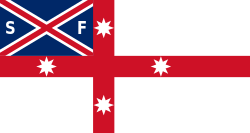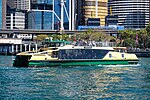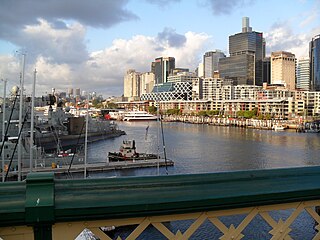
King Street Wharf is a mixed-use tourism, commercial, residential, retail and maritime development on the eastern shore of Darling Harbour, an inlet of Sydney Harbour, Australia. Located on the western side of the city's central business district, the complex served as a maritime industrial area in the early and mid 20th century. It was redeveloped as part of extensive urban renewal projects around Sydney Harbour in the 1980s and 90s. The complex is host to a cluster of nine wharves, with the first two wharves currently in use by private ferry operator Captain Cook Cruises and a third decommissioned by Sydney Ferries.
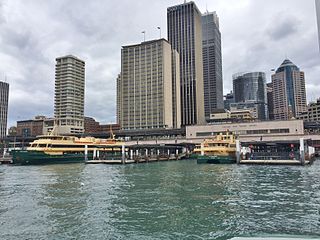
Circular Quay ferry wharf is a complex of wharves at Circular Quay, on Sydney Cove, that serves as the hub for the Sydney Harbour ferry network.

Buses account for close to six per cent of trips each day in the city of Sydney, New South Wales, Australia, forming a key part of the city's public transport system. The network initially evolved from a privately operated system of feeder services to railway stations in the outer suburbs, and a publicly operated network of bus services introduced to replace trams in the inner suburbs. The bus network has undergone major reforms since the 2000s–2010s, with the New South Wales Government taking responsibility for route and fare-setting, opening contracts for most routes up to competitive tendering, and introducing more cross-suburban services.

Milsons Point ferry wharf is located on the northern side of Sydney Harbour serving the Sydney suburb of Milsons Point. It is next to Luna Park and the Sydney Harbour Bridge. It is served by Sydney Ferries Parramatta River and Pyrmont Bay services operated by First Fleet and RiverCat class ferries.

Manly ferry services operate on Sydney Harbour connecting the Sydney suburb of Manly with Circular Quay in the CBD, a journey of seven nautical miles.

Double Bay ferry services connect wharves in Sydney's Eastern Suburbs with Circular Quay by commuter ferry. The services are provided by Sydney Ferries, an agency of the Government of New South Wales. The route is coloured dark green on the current Sydney Ferries network map. SuperCats are the primary vessel on the route with some Double Bay services operated by First Fleet ferries.

Parramatta River ferry services connect suburbs along the Parramatta River in Sydney with Circular Quay by commuter ferry. The services are numbered F3 and form part of the Sydney Ferries network.

Parramatta ferry wharf is located near the source of the Parramatta River, serving the Sydney satellite city of Parramatta.
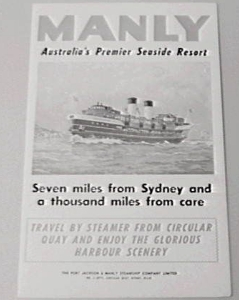
The Port Jackson and Manly Steamship Company (PJ&MSC) was a publicly listed company that operated the Manly ferries in Sydney, Australia. After being taken over by Brambles Industries, the ferry service was eventually taken over by the State Government and is now part of Sydney Ferries.

Bayview Park ferry wharf is a commuter wharf located in the Sydney suburb of Concord, New South Wales, on Hen & Chicken Bay. It is situated adjacent the namesake Bayview Park reserve, and upon the site of the historical Burwood ferry wharf, where Canadian exiles from the 19th century Lower Canada Rebellion landed in Sydney. Bayview Park was originally serviced by a Matilda Cruises route, before being included on Sydney Ferries' Parramatta River service in 2006, after a brief one-year service by Palm Beach Ferries. Services to the wharf were decommissioned by Sydney Ferries in October 2013, alongside Balmain West after patronage declined to a weekly average of 28 passengers. No operators currently service the wharf, although the structure still remains, with plans to return private ferry services to the wharf as part of a redevelopment project for a factory in eastern Concord.

Transdev Sydney Ferries, formerly Harbour City Ferries, is a subsidiary of Transdev Australasia, and is the operator of ferry services in the Sydney Ferries network since July 2012. It currently operates the ferry network under a contract until June 2028. As part of the operation contract, Transdev Sydney Ferries leases both the Balmain Maintenance Facility and the fleet from the government agency Sydney Ferries.
Transdev Australasia is an operator of bus, ferry, light rail and heavy rail services in Australia and New Zealand. It is a subsidiary of French-based, international Transdev. It was formed in 2013 by grouping the operations of Veolia Transport Australia and former Transdev together, as a result of the global rebranding from Veolia Transdev to Transdev.
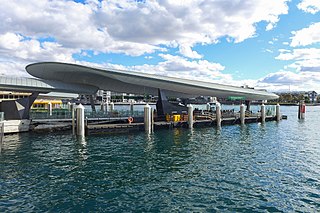
Barangaroo ferry wharf is a ferry wharf located on the eastern side of Darling Harbour, in Sydney, Australia. The wharf is the major public transport link of the Barangaroo precinct, situated west of the Sydney central business district. The complex consists two wharves, with provision for a third wharf in the future. It is serviced by Sydney Ferries' F3 Paramatta River and F4 Pyrmont Bay services. It opened on 26 June 2017.

The Pyrmont Bay ferry service, officially known as F4 Pyrmont Bay, is a commuter ferry service in Sydney, New South Wales. Part of the Sydney Ferries network, it is operated by Transdev Sydney Ferries and services the Lavender Bay and Darling Harbour areas. It began operation on 25 October 2020, and replaced the western half of the F4 Cross Harbour ferry service. Emerald-class ferries and SuperCat ferries operate the service.
Sydney Ferries Limited operated ferry services on Sydney Harbour from 1900 until June 1951.
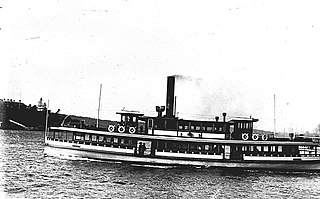
Lady Denman is a former Sydney Harbour ferry built in 1912 for the Balmain New Ferry Company. She was later run by Sydney Ferries Limited and its government successors. She is now preserved at the Jervis Bay Maritime Museum near her original build site in Huskisson, New South Wales, Australia.

The Emerald ferry class is a class of ferry operated by Sydney Ferries on Sydney Harbour. There is capacity for about 400 passengers, improved accessibility for people with disabilities, wi-fi access, luggage and bicycle storage areas and charging stations/ USB ports for electronic devices.

Lady Edeline was a Sydney Harbour ferry built in 1913 for the Balmain New Ferry Company. She and four similar ferries, Lady Chelmsford (1910), Lady Denman (1912), Lady Ferguson (1914), Lady Scott (1914) were a new series of "Lady-class", designed by renowned naval architect, Walter Reeks.

The Watsons Bay ferry service, officially known as F9 Watsons Bay, is a commuter ferry service in Sydney, New South Wales. Part of the Sydney Ferries network, it is operated by Transdev Sydney Ferries and services the Rose Bay and Watsons Bay areas. It began operation on 25 October 2020 and replaced the eastern half of the F4 Cross Harbour service. Emerald-class ferries and SuperCat ferries operate the service.

Sydney Harbour ferry services date back to the first years of Sydney's European settlement. Slow and sporadic boats ran along the Parramatta River from Sydney to Parramatta and served the agricultural settlements in between. By the mid-1830s, speculative ventures established regular services. From the late-nineteenth century the North Shore developed rapidly. A rail connection to Milsons Point took alighting ferry passengers up the North Shore line to Hornsby, New South Wales via North Sydney. Without a bridge connection, increasingly large fleets of steamers serviced the cross harbour routes and in the early twentieth century, Sydney Ferries Limited was the largest ferry operator in the world.



